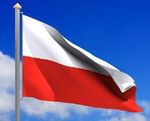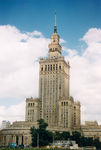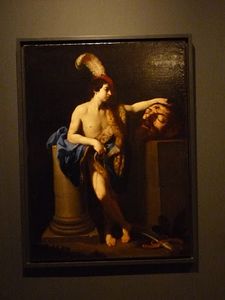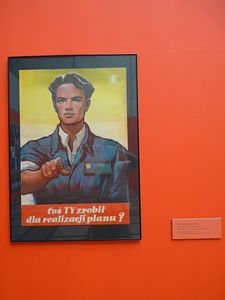Ars Homo Erotica - Une exposition homo-érotique au musée de Varsovie ?

 Il s'agit d'une première en Pologne et en Europe de l'est, et on peut dire que l'exposition aura su déchainer les passions. Ars Homo Erotica est une exposition temporaire autour de l'art homo-érotique, qui s'est déroulée du 11 juin au 5 septembre à Varsovie en Pologne.
Il s'agit d'une première en Pologne et en Europe de l'est, et on peut dire que l'exposition aura su déchainer les passions. Ars Homo Erotica est une exposition temporaire autour de l'art homo-érotique, qui s'est déroulée du 11 juin au 5 septembre à Varsovie en Pologne.
J'ai eu l'occasion de visiter cette exposition et ce fut vraiment magnifique. Voici le discours de présentation.
It was the first time in Poland and Eastern Europe and we can say that the exhibition did reached its aim to burst out passions. Ars Homo Erotica is a temporary exhibition about homoerotism, which took place from the 11th June to the 5th Septembre in Warsaw, Poland.
I did visit this exposition and it was really wonderfull. Here is the launching speech.
11 juin – 5 septembre 2010![]()
Ars Homo Erotica
Conservateur : Paweł Leszkowicz
Designer : Raman Tratsiuk
Assistante : Ewa Witkowska
Artistes participants à l’exposition  Il s’agit d’une exposition d’art historique, politique, érotique et contemporain. Le titre désigne l’art homo-érotique autour du désir et de l’amour entre personne du même sexe. Ars Homo Erotica est une immersion dans la tradition de la culture, tout en touchant aux politiques actuelles en matière de droits des minorités. Elle conjugue la mythologie avec l’histoire de l’art, avec le contemporain et le débat sur les conditions de la démocratie. Elle renforce la philosophie de l’érotisme en tant qu’expérience formatrice aux idées humanistes et l’affirmation de la joie de vivre et du sexe, même face de la répression.
Il s’agit d’une exposition d’art historique, politique, érotique et contemporain. Le titre désigne l’art homo-érotique autour du désir et de l’amour entre personne du même sexe. Ars Homo Erotica est une immersion dans la tradition de la culture, tout en touchant aux politiques actuelles en matière de droits des minorités. Elle conjugue la mythologie avec l’histoire de l’art, avec le contemporain et le débat sur les conditions de la démocratie. Elle renforce la philosophie de l’érotisme en tant qu’expérience formatrice aux idées humanistes et l’affirmation de la joie de vivre et du sexe, même face de la répression.
L’exposition offre une perspective différente de l’histoire de la culture, la collection du Musée et de l’art en Europe centrale et orientale. Elle propose des œuvres de la collection du Musée National de Varsovie, ainsi que des œuvres d’artistes contemporain spécialement invité, de l’histoire de la culture, de l’antiquité jusqu’à nos jours, d’un point de vue de l’imaginaire homosexuel. Cette perspective met l’accent sur un canon d’art et d’amour différent de la civilisation occidentale et le libère des tabous et filtres hétéro-normatif. L’homo-érotisme se montre comme un esthétisme et un cadeau de qualité érotique en tant que représentation visuelle. Le critère de sélection n’est pas l’orientation de l’artiste, mais le thème et le contexte de son œuvre.
 Sélectionner des œuvres dans une perspective d’iconographie homo-érotique masculine et féminine signifie homosexualiser la collection du musée, atteindre les zones de l’inconscient et renouveler les méthodes de présentation. L’objectif est également de révéler et accentuer de nombreux artefacts oubliés et de mettre en avant des significations négligées.
Sélectionner des œuvres dans une perspective d’iconographie homo-érotique masculine et féminine signifie homosexualiser la collection du musée, atteindre les zones de l’inconscient et renouveler les méthodes de présentation. L’objectif est également de révéler et accentuer de nombreux artefacts oubliés et de mettre en avant des significations négligées.
Cette forme d’homosexualité masculine et féminine a changé à travers l’histoire, une diversité universelle. D’où le profil transhistorique et éclectique de la présentation qui présente un monde d’image et d’allusion, de codes et de sous-titres. Il s’agissait de la seule expression de l’homosexualité dans les périodes d’oppression. L’exposition se permet de prendre l’opportunité de rappeler les doubles significations de la mythologie et des histoires bibliques.
Afin de systématiser la multitude de représentation et de métaphore, l’exposition a été divisée en sections thématiques qui juxtaposent les œuvres contemporaines et historiques. Ceci crée une narration avec une politique, un érotisme et une esthétique de qualité.
Entrons dans l’univers homo-érotique mais n’oubliez jamais que l’érotisme et le désir sont plus que les sens et le corps, ils sont des aspects de la vie intérieur de l’être humain, l’histoire de la culture et les politiques du plus. Tous ces niveaux sont présentés dans l’exposition.
 L’exposition commence dans le hall principal. Période de lutte est dédié à l’art engagé dans la politique de la sexualité et des droits de l’homme. Le visiteur découvre l’histoire de la culture à travers la situation politique actuelle en Europe centrale et orientale et gardera ainsi en tête le contexte social tout au long de la visite à travers les différentes dimensions de l’homo-érotisme. Le contexte social a toujours été un sujet controversé, comme c’est le cas aujourd’hui et l’art a toujours été confronté aux normes imposées à la diversité sexuelle.
L’exposition commence dans le hall principal. Période de lutte est dédié à l’art engagé dans la politique de la sexualité et des droits de l’homme. Le visiteur découvre l’histoire de la culture à travers la situation politique actuelle en Europe centrale et orientale et gardera ainsi en tête le contexte social tout au long de la visite à travers les différentes dimensions de l’homo-érotisme. Le contexte social a toujours été un sujet controversé, comme c’est le cas aujourd’hui et l’art a toujours été confronté aux normes imposées à la diversité sexuelle.
Homo-érotisme classique est une galerie de nu classique et classiciste, ainsi que des portraits faisant penser aux dieux antiques et aux héros des histoires et mythes homosexuel. C’est l’origine de l’imagination homosexuelle dans la culture européenne. Le classicisme homo-érotique nous emmène aux racines de la civilisation occidentale, de l’art, de l’érotisme et de la démocratie.
Nus masculins présente différentes formes de nus masculins sensuels du 19ème siècle, des études académiques et des peintures réalistes de l’art contemporain gay.
Couples gays et Ganymède accentue l’iconographie érotique et romantique des couples gays dans les œuvres contemporaine et l’art métaphorique, mythologique et religieux du passé. Nous témoignons d’une homo-mythologie de la relation : Hyacinthe et Apollon, Achilles et Patrocle, David et Goliath, Zeus et Ganymède.
 Saint Sébastien est une section dédiée la plus importante icône homo-érotique du christianisme et à ses imitations des peintures de la renaissance et l’art vidéo.
Saint Sébastien est une section dédiée la plus importante icône homo-érotique du christianisme et à ses imitations des peintures de la renaissance et l’art vidéo.
L’imagination lesbienne est une collection de peintures de différentes féminités à travers l’histoire de l’art. Elle représente la continuité de l’homo-érotisme féminin dans la culture visuelle de Sappho, représentée sur des vases antiques, jusqu’au portraits contemporain de couples lesbiens.
Transgenre est une section en lien avec les concepts et les représentations d’identités à mi-chemin entre les genres, transgressant le système normatif binaire de la sexualité. Les œuvres nous font voyager de l’androgénie mythique aux mascarades contemporaines et aux politiques de contestations des genres.
Les archives présentes des affiches polonaises pour des œuvres de films et pièces de théâtre homosexuel, ainsi que des artistes, régisseurs et comédiens gays.
Paweł Leszkowicz
English
![]() 11 June – 5 September 2010
11 June – 5 September 2010
Ars Homo Erotica
Curator: Paweł Leszkowicz
Designer: Raman Tratsiuk
Assistant curator: Ewa Witkowska
Artists taking part in the exhibition This exhibition is contemporary and historical, erotic and political. The title designates homoerotic art related to same-sex desire and love. Ars Homo Erotica is immersed in the tradition of culture while touching on the current politics of minority rights. It combines myths and the history of art with the contemporary and the debate on the condition of democracy. It builds on the philosophy of eroticism as an experience formative to humanist ideas and their affirmation of the joy of life and sex, even in the face of repression.
This exhibition is contemporary and historical, erotic and political. The title designates homoerotic art related to same-sex desire and love. Ars Homo Erotica is immersed in the tradition of culture while touching on the current politics of minority rights. It combines myths and the history of art with the contemporary and the debate on the condition of democracy. It builds on the philosophy of eroticism as an experience formative to humanist ideas and their affirmation of the joy of life and sex, even in the face of repression.
The exhibition proposes a different perspective on the history of culture, the collection of the Museum, and the art of Central and Eastern Europe. Works from the collection of the National Museum in Warsaw as well as works of specially invited contemporary artists survey the history of culture, from Antiquity until the present, from the point of view of the homosexual imagination. This perspective points to a different canon of art and love in Western civilisation and liberates it of the heteronormative filter and taboo. The homoerotic is taken as an aesthetic and erotic quality present in visual representation. The selection criterion is not the artist’s orientation, it is the theme or context of the work.
To select works from the perspective of female and male homoerotic iconography is to queer the museum collection, to reach areas of the unconscious and to renew the methods of their presentation. It also aims to uncover and accentuate many forgotten artefacts and to highlight neglected meanings.
The forms of male and female homosexuality have differed throughout history, a diversity of universality. Hence the transhistoric and eclectic profile of the presentation which introduces a world of images full of allusions, codes and subtexts. They were the only means of expressing homosexuality in times of oppression. The exhibition affords the opportunity to recall double meanings of mythological and biblical stories.
 In order to systematise the multitude of representations and metaphors, the exhibition has been divided into thematic sections which juxtapose historical and contemporary works of art. This creates a narration with a graded politics, erotics, and aesthetics.
In order to systematise the multitude of representations and metaphors, the exhibition has been divided into thematic sections which juxtapose historical and contemporary works of art. This creates a narration with a graded politics, erotics, and aesthetics.
Let us enter the homoerotic universe but never forget that eroticism and desire are more than the senses and the body: they are aspects of the inner life of human beings, the history of culture, and the politics of mores. All these layers are presented in the exhibition.
The exhibition begins in the main lobby. Time of Struggle is devoted to art engaged in the politics of sexuality and human rights. The visitor is introduced to the history of culture through the current political situation in Central and Eastern Europe and will thus bear in mind the social context when journeying across the various dimensions of the homoerotic. The social context has always been controversial, as it is today, and art has always had to face norms imposed on sexual diversity.
Homoerotic Classicism is a gallery of Classical and Classicist male nudes and portraits reminiscent of antique gods and heroes of homosexual myths and stories. Classicism was an aestheticinspired by the art of ancient Greece and Rome. This is where homosexual imagination of European culture originated. Homoerotic Classicism takes us to the roots of Western civilisation, art, erotics, and democracy.
 Male Nude presents various forms of the sensuous male nude, from 19th century academic studies and realist painting to contemporary gay art.
Male Nude presents various forms of the sensuous male nude, from 19th century academic studies and realist painting to contemporary gay art.
Male Couples and Ganymede accentuate the Romantic and erotic iconography of male couples in literal contemporary works and in the metaphorical, mythological and religious art of the past. We witness a homo-mythology of relationships: Hyacinth and Apollo, Achilles and Patroclus, David and Goliath, Zeus and Ganymede.
Saint Sebastian is the section devoted to the greatest homoerotic icon of Christianity and its impersonations, from Renaissance painting to video art.
Lesbian Imaginarium is a collection of paintings of different femininity throughout the history of art. It presents the continuum of female homoeroticism in visual culture from Sappho, figured on antique vases, to contemporary portraits of lesbian couples.
Transgender is the section of the exhibition relating to concepts and representations of identities located between the genders, transgressing the normative, binary gender system. Works of art take us from mythical androgyny to contemporary masquerades and politics of gender subversion.
Archive presents Polish posters for works of famous homosexual film and theatre directors, playwrights, and artists.
Paweł Leszkowicz
translated by Marcin Łakomski
Polski
![]() 11 czerwca – 5 września 2010
11 czerwca – 5 września 2010
Ars Homo Erotica
Kurator zaproszony do współpracy: dr Paweł Leszkowicz
Projekt ekspozycji: Raman Tratsiuk
Asystentka kuratora: Ewa Witkowska
Artyści biorący udział w wystawie
 Wystawa ma charakter współczesny i historyczny, erotyczny i polityczny. Tytuł oznacza sztukę homoerotyczną związaną z pożądaniem i miłością do tej samej płci. Ars Homo Erotica jest zanurzona w tradycji kultury, ale nawiązuje do aktualnej polityki praw mniejszości. Łączy mity i historię sztuki z teraźniejszością i debatami nad kondycją demokracji. Odnosi się do filozofii erotyzmu jako doświadczenia prowadzącego do humanistycznych idei afirmujących radość życia i seksu, nawet w obliczu represji.
Wystawa ma charakter współczesny i historyczny, erotyczny i polityczny. Tytuł oznacza sztukę homoerotyczną związaną z pożądaniem i miłością do tej samej płci. Ars Homo Erotica jest zanurzona w tradycji kultury, ale nawiązuje do aktualnej polityki praw mniejszości. Łączy mity i historię sztuki z teraźniejszością i debatami nad kondycją demokracji. Odnosi się do filozofii erotyzmu jako doświadczenia prowadzącego do humanistycznych idei afirmujących radość życia i seksu, nawet w obliczu represji.
Wystawa jest propozycją innego spojrzenia na historię kultury, kolekcję muzeum i sztukę Europy Środkowo-Wschodniej. Dzieła wybrane ze zbiorów Muzeum Narodowego w Warszawie oraz prace specjalnie zaproszonych artystek i artystów współczesnych ukazują przekrój przez historię kultury – od antyku do współczesności – z punktu widzenia homoerotycznej wyobraźni. Jest to zwrócenie uwagi na odmienny dla cywilizacji zachodniej kanon sztuki i miłości oraz wydobycie go spod heteronormatywnego filtra i tabu. „Homoerotyka” traktowana jest jako jakość estetyczna i erotyczna obecna w przedstawieniu wizualnym. Kryterium selekcji nie jest więc orientacja artysty lub artystki, ale temat lub kontekst dzieła.
Wybór dzieł pod kątem kobiecej i męskiej ikonografii homoerotycznej pozwala na odmienianie kolekcji muzealnej, docieranie do sfer nieświadomości, odnowę sposobów prezentacji. Wiąże się z odkryciem i zaakcentowaniem wielu obiektów zapomnianych, zwraca uwagę na pomijane znaczenia.
Męski i kobiecy homoseksualizm różnił się w swych formach w zależności od okresu. Jest to różnorodność w uniwersalności. Stąd wynika transhistoryczny i eklektyczny charakter prezentacji wprowadzającej w świat obrazowy pełen aluzji, kodów i podtekstów. Tylko w ten sposób w wielu epokach prześladowany homoseksualizm mógł być wyrażany. Wystawa jest okazją do przypomnienia podwójnych znaczeń mitologicznych lub biblijnych opowieści.
 Aby uporządkować wielość przedstawień i metafor, ekspozycja została podzielona na sekcje tematyczne, gdzie dzieła sztuki dawnej zestawiono ze współczesnymi. Powstaje narracja, która ma swoją stopniowaną politykę, erotykę i estetykę.
Aby uporządkować wielość przedstawień i metafor, ekspozycja została podzielona na sekcje tematyczne, gdzie dzieła sztuki dawnej zestawiono ze współczesnymi. Powstaje narracja, która ma swoją stopniowaną politykę, erotykę i estetykę.
Wejdźmy zatem do homoerotycznego uniwersum, pamiętając, że erotyzm i pożądanie to nie tylko zmysły i ciało, ale także aspekty wewnętrznego życia człowieka, historii kultury i polityki obyczajowej. Wszystkie te wymiary odnajdziemy na wystawie.
Ekspozycję rozpoczyna w holu głównym Czas walki poświęcony sztuce wobec polityki seksualności i praw człowieka. Umożliwia to wprowadzenie w historię kultury poprzez aktualną sytuację polityczną w Europie Środkowo-Wschodniej. Dzięki temu podczas wędrówki przez kolejne wymiary homoerotyki nie zapominamy o kontekście społecznym. We wszystkich epokach był on bowiem równie burzliwy jak obecnie, a sztuka zawsze powstawała wobec norm nałożonych na różnorodność seksualności.
Homoerotyczny klasycyzm to galeria klasycznych i klasycystycznych aktów oraz portretów męskich przypominających antycznych bogów i bohaterów, z którymi związane są homoseksualne mity i historie. Klasycyzm to estetyka inspirowana sztuką starożytnej Grecji i Rzymu. W kulturze europejskiej wyobraźnia homoseksualna wywodzi się także stamtąd. Homoerotyczny klasycyzm prowadzi nas zatem do źródeł zachodniej cywilizacji, sztuki, erotyki i demokracji.
 Akt męski przedstawia różne formuły zmysłowego aktu męskiego, od XIX-wiecznych studiów akademickich i malarstwa realistycznego po współczesną sztukę gejowską.
Akt męski przedstawia różne formuły zmysłowego aktu męskiego, od XIX-wiecznych studiów akademickich i malarstwa realistycznego po współczesną sztukę gejowską.
Pary męskie i Ganimedes akcentują romantyczną i erotyczną ikonografię par męskich w dosłownych pracach współczesnych oraz w dawnej metaforycznej sztuce mitologicznej i religijnej. Oglądamy homomitologię związków Hiacynta i Apolla, Achillesa i Patroklesa, Dawida i Goliata, Zeusa i Ganimedesa.
Święty Sebastian to sekcja poświęcona największej homoerotycznej ikonie chrześcijaństwa i jej wcieleniom, od renesansowego malarstwa po sztukę wideo.
Imaginarium lesbijskie jest kolekcją obrazów innej kobiecości w całej historii sztuki. Prezentujemy continuum kobiecego homoerotyzmu, które istnieje w kulturze wizualnej od Safony na antycznych wazach po współczesne portrety lesbijskich par.
Transgender to sekcja wystawy i pojęcie dotyczące wyobrażeń tożsamości, które są pomiędzy płciami, przekraczając normatywny binarny system płciowy. Sztuka prowadzi od mitycznej androgynii do nowoczesnych maskarad i polityki podważania płci.
Archiwum prezentuje polskie plakaty reklamujące słynne dzieła znanych homoseksualnych reżyserów, dramaturgów i artystów.
Paweł Leszkowicz





/http%3A%2F%2Fstorage.canalblog.com%2F62%2F67%2F629446%2F96419132_o.jpg)
/http%3A%2F%2Fstorage.canalblog.com%2F66%2F04%2F629446%2F94474585_o.jpg)
/http%3A%2F%2Fstorage.canalblog.com%2F90%2F60%2F629446%2F91582961_o.jpg)
/http%3A%2F%2Fstorage.canalblog.com%2F14%2F29%2F629446%2F89659494_o.jpg)